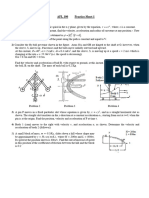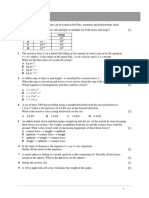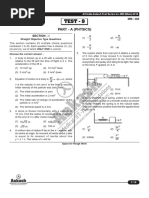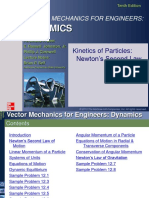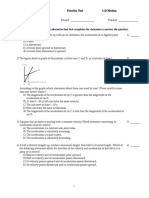TYK 8 Questions
TYK 8 Questions
Uploaded by
Isaac HanssenCopyright:
Available Formats
TYK 8 Questions
TYK 8 Questions
Uploaded by
Isaac HanssenOriginal Description:
Original Title
Copyright
Available Formats
Share this document
Did you find this document useful?
Is this content inappropriate?
Copyright:
Available Formats
TYK 8 Questions
TYK 8 Questions
Uploaded by
Isaac HanssenCopyright:
Available Formats
Week Five – Test Questions
These questions will test your knowledge of the weekly content and are taken from Fundamentals of
Applied Dynamics, JH Williams Jr, 1996, Wiley.
Example 1
As sketched in the figure, a ship is rolling at a
constant angular velocity 𝜔1 about the 𝑋
direction, with respect to ground, and is pitching
at a constant angular velocity 𝜔2 about the 𝑌
direction, with respect to ground. The radar
antenna located on the ship is rotating at a
constant angular velocity 𝜔0 about the 𝑍
direction, with respect to the pitching and rolling
ship.
Find the angular velocity and angular
acceleration of the radar antenna (with respect
to the ground) at the instant shown.
Solution is in the Example Problems folder under
Topic 5 on LMS
Example 2
A rod of length𝑙 with a wheel of radius𝑟 attached
to one of its ends is rotating
about a vertical axis 𝐴𝐴 at a constant angular
velocity 𝛺, as sketched in the figure. The rod is in a
horizontal plane and
the disk is in a vertical plane. The wheel is
rolling without slip on the horizontal
supporting surface, as shown.
Find the angular velocity and angular
acceleration of the wheel (with respect to
the ground).
Solution is in the Example Problems folder under
Topic 5 on LMS
Question 1
A disk is spinning on a shaft 𝐴𝐵 and rotates at an angular velocity
𝜔2 = 15 𝑟𝑒𝑣/𝑠 with respect to shaft 𝐴𝐵, as shown. Shaft 𝐴𝐵 is
mounted on a cone-shaped base of conical angle 25°, which is
rotating about its axis 𝐶𝐷 at an angular velocity 𝜔1 = 200 𝑟𝑒𝑣/𝑠,
with respect to ground.
Find the angular acceleration of the disk (with respect to ground).
Question 2
A boy is spinning a bucket of water such that the bucket
moves in a circle of radius 𝑅 in the vertical plane at a constant
speed 𝑣, as shown.
Determine the acceleration of the bucket (with respect to
ground) at locations 𝐴 and 𝐵; that is, the highest and lowest
points of the path.
The reference frames in the sketch are as follows: 𝑂𝑋𝑌𝑍 is
fixed to the ground; 𝑂𝑥𝑦𝑧 is fixed to the rope.
Question 3
An amusement park ride consists of swinging arms (only two are shown) pinned to a rotating
column, as shown. As the column rotates at a constant rate, the arms swing out. Each swinging arm
has an effective length of 50 𝑓𝑒𝑒𝑡. At the instant
shown, the column is rotating at 0.225 𝑟𝑒𝑣/𝑠𝑒𝑐 and
the arms form an angle of 50° with respect to
the vertical.
Find the velocity and acceleration of the crouched
rider inside the cage labelled 𝐴, at the instant shown
(with respect to ground).
The reference frames in the sketch are as follows:
𝑂𝑋𝑌𝑍 is fixed to the ground; 𝑂𝑥𝑦𝑧 is fixed to the
swinging arm.
Question 4
A centrifuge is often used for astronaut training.
A simplified version is shown, in which a cockpit
is rigidly attached to an arm that is driven by a
motor. If in a particular test, starting from rest,
the driving motor supplies a constant angular
acceleration of 0.5 𝑟𝑎𝑑/𝑠 2 , and the distance
from the astronaut’s navel to the rotation axis is
10 𝑚, find the acceleration of the astronaut’s
navel as a function of time (with respect to
the ground).
The reference frames in the sketch are as follows: 𝑂𝑋𝑌𝑍 is fixed to the ground; 𝑂𝑥𝑦𝑧 is fixed to the
arm.
Question 5
Rotor blades of a helicopter are of radius 5.2 𝑚 and rotating at a constant angular velocity of
5 𝑟𝑒𝑣/𝑠. The helicopter is flying horizontally in a straight line at a speed of 5 𝑚/𝑠 and an
acceleration of 0.5 𝑚/𝑠 2 , as shown.
Find the velocity and acceleration of point 𝐴, the outermost tip of a blade (with respect to ground),
when 𝜃 is 0°, 90°, and 180°.
The reference frames in the sketch are as follows: 𝑂𝑋𝑌𝑍 is fixed to the ground; 𝑂𝑥𝑦𝑧 is fixed to the
translating helicopter.
You might also like
- How To Build and Operate Shaker TablesDocument69 pagesHow To Build and Operate Shaker TablesAFLAC ............92% (26)
- NA 2 Notes 1 - Propeller GeometryDocument12 pagesNA 2 Notes 1 - Propeller GeometrySudheendra ckNo ratings yet
- Gyroscopes and Gyroscopic Effects NOTESDocument26 pagesGyroscopes and Gyroscopic Effects NOTESDR. EvansNo ratings yet
- GyroscopeDocument21 pagesGyroscopeVijay GorfadNo ratings yet
- Gandhinagar Institute of Technology: Topic: Effect of Gyroscopic Couple On An Aero-PlaneDocument14 pagesGandhinagar Institute of Technology: Topic: Effect of Gyroscopic Couple On An Aero-Planehorizon designsNo ratings yet
- 5-Mechanism For ControlDocument164 pages5-Mechanism For ControlsolomonrajarNo ratings yet
- 2151902Document49 pages2151902swarajNo ratings yet
- Gyroscope: Presented By: Akshay Agrawal Bits Edu CampusDocument52 pagesGyroscope: Presented By: Akshay Agrawal Bits Edu CampusNirmal KushwahaNo ratings yet
- Module 7.2 Gyroscope1Document63 pagesModule 7.2 Gyroscope1harvarNo ratings yet
- Unit 7 Gyroscope English PDFDocument60 pagesUnit 7 Gyroscope English PDFChiến ThầnNo ratings yet
- Gyroscopic CoupleDocument64 pagesGyroscopic Couplepapercrown0497No ratings yet
- Unit 7 Gyroscope 131127011945 Phpapp02Document40 pagesUnit 7 Gyroscope 131127011945 Phpapp02VarunRajNo ratings yet
- GyroscopeDocument10 pagesGyroscopeAzad DuppalaNo ratings yet
- What Is: GyroscopeDocument48 pagesWhat Is: GyroscopekeerthivNo ratings yet
- GyroscopeDocument14 pagesGyroscopeSahil SharmaNo ratings yet
- Gyroscope 01 PDFDocument52 pagesGyroscope 01 PDFAnurag GuptaNo ratings yet
- Effect of Gyroscopic Couple On A NAVAL SHIPDocument16 pagesEffect of Gyroscopic Couple On A NAVAL SHIPaakash waychal100% (3)
- 11/6/2014 Hareesha N G, Dept of Aero Engg, DSCE, Blore 2Document46 pages11/6/2014 Hareesha N G, Dept of Aero Engg, DSCE, Blore 2sahil thakurNo ratings yet
- GYROSCOPEDocument12 pagesGYROSCOPEsrsoumyankNo ratings yet
- Effect of Gyroscopic Couple On A NAVAL SHIPDocument16 pagesEffect of Gyroscopic Couple On A NAVAL SHIPdada100% (1)
- Gyroscope: Definition: A Gyroscope May Be Defined As ADocument11 pagesGyroscope: Definition: A Gyroscope May Be Defined As AtewodrosNo ratings yet
- Gyroscopic CoupleDocument6 pagesGyroscopic CoupleDevesh KumarNo ratings yet
- GyroscopeDocument27 pagesGyroscopeLisa Goodwin100% (1)
- g11 Gyroscope RepeatDocument26 pagesg11 Gyroscope RepeatAniket SankpalNo ratings yet
- GyroscopeDocument116 pagesGyroscopeSAI PRAMOD RAVADANo ratings yet
- Chap 2 Gyroscopic Effect-1Document18 pagesChap 2 Gyroscopic Effect-1bjxhtsxb26No ratings yet
- GyroDocument2 pagesGyroAmit PandeyNo ratings yet
- 03 Gyroscopic CoupleDocument33 pages03 Gyroscopic Couplesushil.chhetri3No ratings yet
- Dom Unit - 4Document16 pagesDom Unit - 4Gbm RajNo ratings yet
- Jee Advanced ++ PhysicsDocument22 pagesJee Advanced ++ Physicssarojalpesh260No ratings yet
- Flight Dynamics (Fixed-Wing Aircraft)Document17 pagesFlight Dynamics (Fixed-Wing Aircraft)VigneshVickeyNo ratings yet
- GyroscopeDocument11 pagesGyroscopedr.dekstopNo ratings yet
- 03 Gyroscopic CoupleDocument30 pages03 Gyroscopic CoupleSagar NeupaneNo ratings yet
- GYRO Key (Q - A)Document10 pagesGYRO Key (Q - A)Chirattakkattu HouseNo ratings yet
- Chapter 4 Motion in Two and Three DimensionsDocument27 pagesChapter 4 Motion in Two and Three DimensionsEliseo Alminaza Jr.No ratings yet
- Gyroscope-Theory and ProblemsDocument89 pagesGyroscope-Theory and ProblemsMihir MandhareNo ratings yet
- On GyroDocument41 pagesOn GyroShyam Pandey100% (1)
- An Overview: Presenter: Muhammad Khurram Javed 2008-EP-17Document40 pagesAn Overview: Presenter: Muhammad Khurram Javed 2008-EP-17Hew LetNo ratings yet
- Module 5Document8 pagesModule 5Benson MataNo ratings yet
- GyroscopeDocument24 pagesGyroscopeSahil Sharma100% (13)
- Gyroscopic Couple and Precessional Motion: Active ForceDocument5 pagesGyroscopic Couple and Precessional Motion: Active ForceAhmad RazaNo ratings yet
- M ERIAMDocument51 pagesM ERIAMsauravkr2027No ratings yet
- Anmol's DomDocument38 pagesAnmol's DomKishan KumarNo ratings yet
- Gyroscopic CoupleDocument10 pagesGyroscopic CoupleAnandha RamanNo ratings yet
- Gyroscope Theory of MachinesDocument33 pagesGyroscope Theory of Machinesadel audayNo ratings yet
- Gyroscope - Gyroscopic Effects On The Movement Of: Airplanes and Ships - Gyroscope StabilizationDocument25 pagesGyroscope - Gyroscopic Effects On The Movement Of: Airplanes and Ships - Gyroscope StabilizationAbdur Rahman100% (1)
- Chapter 14 - GyroscopesDocument54 pagesChapter 14 - Gyroscopesnigatudesta21No ratings yet
- Gyroscope NotesDocument26 pagesGyroscope NotesLauria LavdaNo ratings yet
- AENG 512-3: Assignment No. 3Document6 pagesAENG 512-3: Assignment No. 3Paul GernahNo ratings yet
- 01 Gyroscope CompressedDocument41 pages01 Gyroscope CompressedAneesh KumarNo ratings yet
- Rotation v2Document15 pagesRotation v2labib.rafi264No ratings yet
- Gyrocompass, Auxiliary Gyrocompass, and Dead Reckoning Analyzing Indicator and Tracer SystemsDocument36 pagesGyrocompass, Auxiliary Gyrocompass, and Dead Reckoning Analyzing Indicator and Tracer SystemsArya NandanaNo ratings yet
- Precision & GyroscopeDocument53 pagesPrecision & GyroscopeVenkateswar Reddy MallepallyNo ratings yet
- Presenter:: Bariya Pratikkumar R. Gandhi Rushi A. Bhatwadekar Chaitanya SDocument40 pagesPresenter:: Bariya Pratikkumar R. Gandhi Rushi A. Bhatwadekar Chaitanya SPratik BariyaNo ratings yet
- Helicopter PPT 1Document18 pagesHelicopter PPT 1Sunil PanwarNo ratings yet
- Gyro NotesDocument12 pagesGyro NotesManupriya Singh100% (2)
- Heel TurningDocument5 pagesHeel TurningShanilNo ratings yet
- ReportDocument13 pagesReportMamta SindhuNo ratings yet
- Model aeroplanes: The building of model monoplanes, biplanes, etc., together with a chapter on building a model airshipFrom EverandModel aeroplanes: The building of model monoplanes, biplanes, etc., together with a chapter on building a model airshipNo ratings yet
- Miscellany 51: Apparent Wind Speed and True Wind SpeedFrom EverandMiscellany 51: Apparent Wind Speed and True Wind SpeedNo ratings yet
- Watch and Clock Escapements A Complete Study in Theory and Practice of the Lever, Cylinder and Chronometer Escapements, Together with a Brief Account of the Origin and Evolution of the Escapement in HorologyFrom EverandWatch and Clock Escapements A Complete Study in Theory and Practice of the Lever, Cylinder and Chronometer Escapements, Together with a Brief Account of the Origin and Evolution of the Escapement in HorologyNo ratings yet
- Chap3.5 RedBookDocument12 pagesChap3.5 RedBookIsaac HanssenNo ratings yet
- Reading Assignment 8 Williams CHP 3Document34 pagesReading Assignment 8 Williams CHP 3Isaac HanssenNo ratings yet
- Ch3 p77-85Document9 pagesCh3 p77-85Isaac HanssenNo ratings yet
- Slides On Lagr Eq of The First Kind - 11 09 2023Document4 pagesSlides On Lagr Eq of The First Kind - 11 09 2023Isaac HanssenNo ratings yet
- Buoyancy CalculationDocument11 pagesBuoyancy CalculationDuong VuNo ratings yet
- Electric Potential: ElectromagnetismDocument6 pagesElectric Potential: ElectromagnetismbairongarciaNo ratings yet
- 3 DynamicsDocument3 pages3 DynamicsAmmar YasirNo ratings yet
- ME 31 Kinematics Sample Problems Velocity Analysis PDFDocument60 pagesME 31 Kinematics Sample Problems Velocity Analysis PDFAmadeo ErebaraNo ratings yet
- Non - Rectangular Components: Prepared By: D.M.ODocument5 pagesNon - Rectangular Components: Prepared By: D.M.OCiero John MarkNo ratings yet
- Aiatsoyjmo2016t09 SolutionDocument27 pagesAiatsoyjmo2016t09 SolutionKARNANo ratings yet
- Chapter 4 Motion in Two Dimensions: Wen-Bin Jian (簡紋濱) Department of Electrophysics National Chiao Tung UniversityDocument21 pagesChapter 4 Motion in Two Dimensions: Wen-Bin Jian (簡紋濱) Department of Electrophysics National Chiao Tung UniversitySimlindile NgobelaNo ratings yet
- 3.4.1.5 Newtons Laws of MotionDocument96 pages3.4.1.5 Newtons Laws of Motionprashyam20No ratings yet
- TinyG Wiki GitHubDocument4 pagesTinyG Wiki GitHubdangkhuyenmaiNo ratings yet
- Physics Problems: Fei Liu October 25, 2019Document17 pagesPhysics Problems: Fei Liu October 25, 2019Boldie LutwigNo ratings yet
- Project: Applied Physics (EE-117)Document7 pagesProject: Applied Physics (EE-117)Muhammad HasanNo ratings yet
- Tom MCQ UNIT 2Document14 pagesTom MCQ UNIT 2Kumar PachareNo ratings yet
- 1203020415Document376 pages1203020415Rahul Jori100% (1)
- Chapter12 HandoutDocument38 pagesChapter12 HandoutinhinyeroNo ratings yet
- 18 Engineering Reference - Motor Selection and Sizing PDFDocument5 pages18 Engineering Reference - Motor Selection and Sizing PDFSamik MukherjeeNo ratings yet
- Lesson Plan For SpeedDocument2 pagesLesson Plan For SpeedJonard Pacres AbrasadoNo ratings yet
- Traffic Engineering Handbook - 540 PgsDocument536 pagesTraffic Engineering Handbook - 540 Pgskagetsuki100% (9)
- EquationsDocument182 pagesEquationsmanjeet YadavNo ratings yet
- AH RMA PPT 1.-KineRelDocument16 pagesAH RMA PPT 1.-KineRelFrank SkellyNo ratings yet
- 1-D Motion Practice TestDocument7 pages1-D Motion Practice TestIman AhmedNo ratings yet
- Physics Chapter 2Document54 pagesPhysics Chapter 2kk.sheela243No ratings yet
- Kom 3rd Unit QuestionDocument1 pageKom 3rd Unit QuestionDamo Daran GNo ratings yet
- 50 100 050 - Pu 30 100 0 30 - PuDocument40 pages50 100 050 - Pu 30 100 0 30 - Puryan andriantoNo ratings yet
- Research Paper On ElectrodynamicsDocument9 pagesResearch Paper On ElectrodynamicsMizanur RahmanNo ratings yet
- 02-Rectilinear MotionQ28-Q39Document3 pages02-Rectilinear MotionQ28-Q39Saksham PatelNo ratings yet
- Taller PDFDocument19 pagesTaller PDFRoberto Sanchez FigueroaNo ratings yet
- Chapter 12 - Lecture 3Document18 pagesChapter 12 - Lecture 3Omar SidawiNo ratings yet
- Gravitomagnetism and The Clock EffectDocument27 pagesGravitomagnetism and The Clock EffectJohn BirdNo ratings yet
- LM Physics Section 2 LVersionDocument48 pagesLM Physics Section 2 LVersionsoarojnrNo ratings yet





























